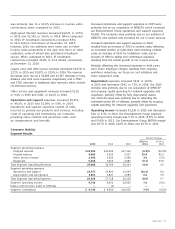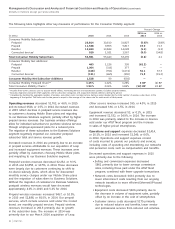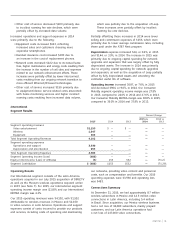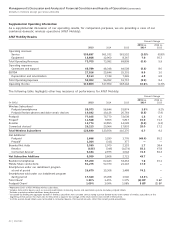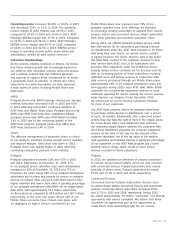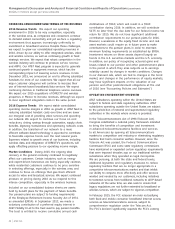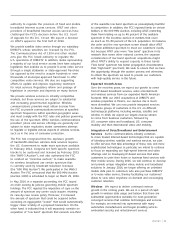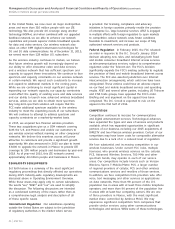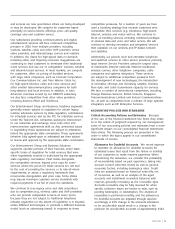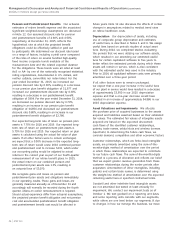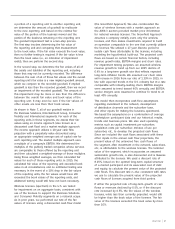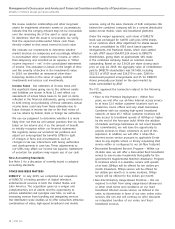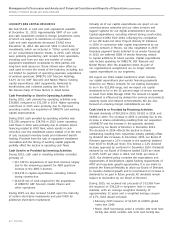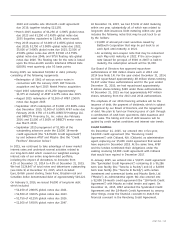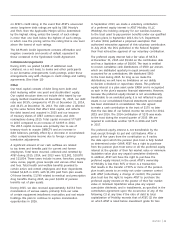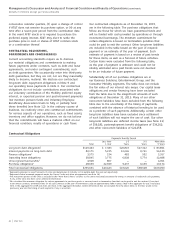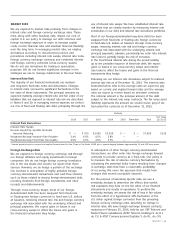AT&T Wireless 2015 Annual Report Download - page 28
Download and view the complete annual report
Please find page 28 of the 2015 AT&T Wireless annual report below. You can navigate through the pages in the report by either clicking on the pages listed below, or by using the keyword search tool below to find specific information within the annual report.
Management’s Discussion and Analysis of Financial Condition and Results of Operations (continued)
Dollars in millions except per share amounts
26
|
AT&T INC.
future years. Note12 also discusses the effects of certain
changes in assumptions related to medical trend rates
on retiree healthcare costs.
Depreciation Our depreciation of assets, including
use of composite group depreciation and estimates
of useful lives, is described in Notes1 and 6. We assign
useful lives based on periodic studies of actual asset
lives. During 2014, we completed studies evaluating
the periods that we were utilizing our software assets,
which resulted in our extending our estimated useful
lives for certain capitalized software to five years to
better reflect the estimated periods during which these
assets will remain in service, which is also consistent
with the estimated useful lives used in the industry.
Prior to 2014, all capitalized software costs were primarily
amortized over a three-year period.
If all other factors were to remain unchanged,
we expect that a one-year increase in the useful lives
of our plant in service would have resulted in a decrease
of approximately $3,550 in our 2015 depreciation
expense and that a one-year decrease would have
resulted in an increase of approximately $4,886 in our
2015 depreciation expense.
Asset Valuations and Impairments We allocate
the purchase price of acquired businesses to the assets
acquired and liabilities assumed based on their estimated
fair values. The estimated fair values of intangible assets
acquired are based on the expected discounted
cash flows of the identified customer relationships,
patents, trade names, orbital slots and wireless licenses
(spectrum). In determining the future cash flows, we
consider demand, competition and other economic factors.
Customer relationships, which are finite-lived intangible
assets, are primarily amortized using the sum-of-the-
months-digits method of amortization over the period
in which those relationships are expected to contribute
to our future cash flows. The sum-of-the-months-digits
method is a process of allocation and reflects our belief
that we expect greater revenue generation from these
customer relationships during the earlier periods after
acquisition. Amortization of other intangibles, including
patents and certain trade names, is determined using
the straight-line method of amortization over the expected
remaining useful lives or specified contractual terms.
Goodwill and other indefinite lived intangible assets
are not amortized but tested at least annually for
impairment. We conduct our impairment tests as of
October 1. We test goodwill on a reporting unit basis,
and some reporting units coincide with our segments,
while others are one level below our segments. If, due
to changes in how we manage the business, we move
Pension and Postretirement Benefits Our actuarial
estimates of retiree benefit expense and the associated
significant weighted-average assumptions are discussed
in Note12. Our assumed discount rate for pension
and postretirement benefits of 4.60% and 4.50%,
respectively, at December31,2015, reflects the
hypothetical rate at which the projected benefit
obligations could be effectively settled or paid out
to participants. We determined our discount rate based
on a range of factors, including a yield curve composed
of the rates of return on several hundred high-quality,
fixed income corporate bonds available at the
measurement date and the related expected duration
for the obligations. These bonds were all rated at least
Aa3 or AA- by one of the nationally recognized statistical
rating organizations, denominated in U.S. dollars, and
neither callable, convertible nor index linked. For the
year ended December31,2015, we increased our
pension discount rate by 0.30%, resulting in a decrease
in our pension plan benefit obligation of $1,977 and
increased our postretirement discount rate by 0.30%,
resulting in a decrease in our postretirement benefit
obligation of $854. For the year ended December31,2014,
we decreased our pension discount rate by 0.70%,
resulting in an increase in our pension plan benefit
obligation of $4,854 and decreased our postretirement
discount rate 0.80%, resulting in an increase in our
postretirement benefit obligation of $2,786.
Our expected long-term rate of return on pension plan
assets is 7.75% for 2016 and 2015. Our expected long-
term rate of return on postretirement plan assets is
5.75% for 2016 and 2015. Our expected return on plan
assets is calculated using the actual fair value of plan
assets. If all other factors were to remain unchanged,
we expect that a 0.50% decrease in the expected long-
term rate of return would cause 2016 combined pension
and postretirement cost to increase $232, which under
our accounting policy would be adjusted to actual
returns in the current year as part of our fourth-quarter
remeasurement of our retiree benefit plans. In 2015,
the actual return on our combined pension and
postretirement plan assets was 1.3%, resulting in
an actuarial loss of $3,070.
We recognize gains and losses on pension and
postretirement plan assets and obligations immediately
in our operating results. These gains and losses are
generally measured annually as of December31 and
accordingly will normally be recorded during the fourth
quarter, unless an earlier remeasurement is required.
Should actual experience differ from actuarial assumptions,
the projected pension benefit obligation and net pension
cost and accumulated postretirement benefit obligation
and postretirement benefit cost would be affected in



